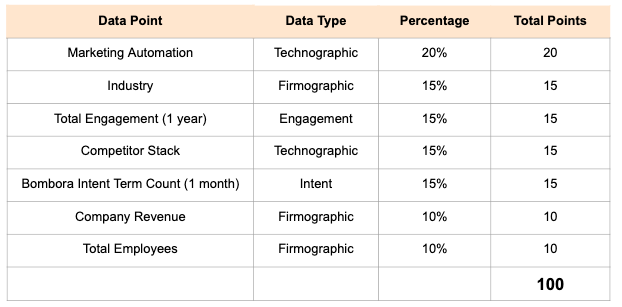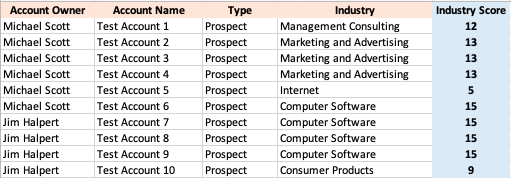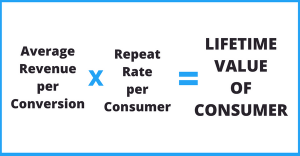
Selecting target accounts can be stressful. You worked hard to build trust across your Sales team, and now comes a project that could ruin that hard-won trust if you don’t execute it perfectly. Guess what? It is not (and never will be) perfect. This activity can’t be done in a Marketing silo. Marketing needs Sales, and Sales needs Marketing to accurately select target accounts. And don’t forget about your Customer Success team!
So repeat after me: Selecting target accounts is a cross-functional project.
Now, I know what you’re thinking — “Sounds great, but building the model is hard and everything I read on the internet is just high level. And I need to know how to actually do it!”
I hear you, and I’m here to help. Follow these seven steps, and I promise you’ll look back laughing about how stressed out you got when you heard the phrase “target account model.”
- Identify the data points that make up your ICP
- Understand what you have and what you lack in terms of company data
- Review the data provided by third party data vendors
- Standardize data
- Find commonalities amongst your customers
- Rank and score your data points
- Review, remove, format and share!
Now let’s dive into each of these steps, shall we?
1. Identify the data points that make up your ICP
Data is great, and at this point you probably have more than you know what to do with. Don’t worry, Sales and Customer Success are here to help. Your AE/SDR teams are in the weeds everyday qualifying prospects and closing deals. Utilize their expertise. I find meeting individually always gives me the best feedback versus putting everyone in a conference room. They may have a checklist or scoring system of their own to qualify accounts, but at the very least they can provide insights, such as “industry matters a lot more than company size” or “a company with technology X is more likely to purchase our product than a company with technology Z.”
One of my favorite ways to gain these insights is to list all the fields I plan on using in my model and then ask them to rank them in order of importance. This simple exercise allows me to see how Sales perceives the data, which helps me start building out my model. For example, if the majority of sales people rank industry as high and company revenue as low, I can assume that assigning Industry a higher score than Revenue will aid my model.
But we’re not done yet. Remember that this is cross functional, and who knows more about what makes a good customer than the Customer Success team? Providing them with the same ranking exercise will help, but it’s even better to ask them about what defines a “good” or “bad” customer. Look out for applicable trends, such as “we see accounts in industry X churn at a much higher rate than other industries,” or “if a customer has under X number of employees, we really see them struggle with stickiness/adoption.”
This is also a great time to ask both Sales and CS about any data that would indicate if an account isn’t worth attempting to sell to. This could be as simple as saying “they use technology X, and we can’t integrate to technology X,” or “we don’t sell to these lists of countries.” Knowing what automatically disqualifies an account is just as important as knowing what qualifies them.
2. Understand what you have and what you lack in terms of company data
Chances are if you’re reading this, we can safely assume your company has a CRM and
MAP platform, which means you already have data on customers, prospects, and accounts. If this isn’t your company’s first attempt at target account selection, you probably inherited some old documents that summarize how this process was done in the past. While that old model might not have been amazing, it can help guide you.
Whether it’s industry, geographic location, company size, technology used, revenue, etc., your CRM/MAP have data that shouldn’t be ignored. However, that doesn’t mean every Account has a full set of data, and (take a deep breath) THAT’S OKAY!
One of my biggest indicators that an account is a good fit for Engagio is if they have a marketing automation platform. Unfortunately, not every account in my system has this data. But again, that’s okay! No one’s data is perfect or complete, so step off the ledge, grab a drink, and let’s get back to work.
A good starting point is to classify your data into buckets. I use the following:
- Firmographic
- Technographic
- Intent
- Engagement
For an explanation of each type, check out this post.
Look over your data and start classifying it into these buckets. This will make it easier to see if you have any gaps in your data. For example, you may have many fields/data points for the engagement and firmographic buckets but limited within technographic and intent. Knowing your data gaps will be crucial for the next step.
3. Review the data provided by third party data vendors
Not everyone uses a third party data vendor, and there’s nothing wrong with that. But if you do, you should know what data is available that could aid you in this process. Since we already created the four data buckets and know where the gaps lie, we can now use third party data to help to fill in those gaps.
One of my favorite third party data methods is website scraping. While it may not be 100% accurate (when was the last time you cleaned up your Google Tag Manager?), it can help provide an indication that a company has been exposed to your space/tech by having a competitor or complimentary product on their website.
For this website scraping example, we know the data isn’t 100% accurate, so we treat it on a scale. Take Marketing Automation Platforms (MAP) – one company might show that they have Marketo, Eloqua and Hubspot. It’s highly unlikely that one company has all three, therefore it indicates that this company has been trying or tried all three platforms. This shows us that they have evolved or are trying to be more complex in their marketing automation practices. The assumption here is that the more MAP scripts we find on a website, the higher the probability that they’re planning on implementing some type of ABM approach.
Just like your CRM data, this isn’t going to be perfect, and your model won’t be either. The purpose here is to gather as many leading indicators as possible, and utilize them within your model.
4. Standardize your data
Now that you’ve gathered all your data, I’m sure you’ve noticed that some of it is a bit messy. Don’t worry, you’re not alone! With all the different technologies, human input and general changes over time, we all experience this type of “data drift” in our systems. But now is the day of data reckoning.
If you notice you have 100 different industry values, ask yourself if they’re all really needed. Can you scale it down to a smaller set, maybe only 50? Or maybe you only have 50 industry values but some of them are duplicates, such as “Consumer Products” and “Consumer Product.” To start scoring for your model, you’re going to want this to be as clean as possible, and your coworkers will appreciate the clean data.
This is also a great time to make a general cleaning/standardization effort. I know from my experience building target account models, I usually uncover a field or two that could use some operational love. While this may not be your initial goal, it’s good to fix things as you go and set yourself up for success later on.
5. Find commonalities amongst your customers
At this point in the process you should have your four data buckets, fields within each, and no discrepancies in the data for each field. Let’s go back to your CRM and third party data vendors and pull that data for your customer accounts. A few additional insights to pull about your customers could be things such as total ARR, customer health, total count of products owned, or total time as a customer. Each business will have different “good customer” indicators. If you don’t know them, ask your CS team!
Take this data, and let’s start figuring out how popular each data point is across your customer base. For example, if you’re looking at the industry field, you can run a simple count function in Excel to understand the most popular industries across all your customers. The results may shock you!
Next you can start pulling those “good customer” data points, such as total ARR, to add an extra layer of depth to your analysis. Let’s say your most popular industries are computer software and consumer products, with a count of 100 and 75 respectively. However, after pulling in, for example, total ARR and customer health, you might notice that consumer products customers actually have a higher average total ARR and a more consistently positive customer health score. Without this additional insight, you may have scored the computer software industry as the highest ranking value. Yet with this new lens, you should probably consider making them equal or even ranking consumer products slightly higher because they’re a “more profitable” customer.
6. Rank and score all your data points
Finally, the part we’ve all been waiting for. (Cue drum roll…) BUILDING THE MODEL!
We have the data we need, we know what Sales and CS consider important, the data is clean, and the trends amongst our customers have been uncovered.
The initial question you should ask is, what should your total score be for an account? Personally, I like having a 100pt model, but any number will work; you just need to make sure you score each data point accordingly. This part of the project is going to be different for everyone reading this, but some factors to take into consideration are:
- What are the most important fields to your account ICP classification?
- What are the most important fields to Sales?
- Which values in each data point should be deemed most and least valuable?
Once you have those questions answered, you can start to build our your model and visualize it with a simple table like the one below:

Now comes the fun part – scoring all of your accounts. Given the amount of data you’re about to utilize, the most important, best practice I can offer is to have a different file for each data point that you’re scoring. This means you pull all your accounts, then score one data point such as Industry, save the file, and create a new one for the next data point. The reason for this is that Excel can crash sometimes. You’re going to change your scores, and this makes it a lot easier to dive into a score later on. Another great best practice is to have the account IDs in every file in case you have accounts with the same name.
Let’s keep this simple and say you’re scoring industry, country, technologies used, and intent. This means you should have a file for industry, country, technology used, and intent. Once each file is complete with scoring, create a new file showing all your accounts and simply use the account ID and the VLOOKUP function to pull in the score for each account and their data points.

Once all your data points have been added with their respective scores, use the SUM() function in Excel to calculate the total score for the account. If you want to get real fancy, you could even create total scores for each of the data buckets you created earlier in the process.
7. Remove, format and share!
You’re so close! Just one step left, and in my opinion, it’s the most important step of them all. There’s been a lot of work done so far, and we don’t want it to go to waste just because someone found a high-scored account that doesn’t fit the ICP. During step two, you learned what data would auto-DQ an account, and now is when you utilize that information.
Find all the accounts that have these types of auto-DQ data points. Once you identify them, you have two options: either remove them entirely from your data set, or find a way to DQ them within your systems. I recommend doing both. There’s no reason to show these accounts to Sales, and it’s a perfect time to revisit your account DQ process. It’s even possible that these auto-DQ accounts scored highly in other aspects of the model. By not removing them, you risk Sales viewing your model as inaccurate.
After those accounts have been removed, you need to start setting yourself and your reps up for success by formatting the file. I recommend splitting up the file of all accounts into individual files for each rep. So if you have ten reps, you’ll have ten personalized files. Each of those files should have two tabs: one that shows all the account information plus the score they received from the model, and one that shows the same account information and the data values that were used for scoring. While one tab shows that the industry score for the Google account is 15, the other tab shows that the Google account industry value is technology. This segmentation will help your reps see both the score and what created that score. Once you have these files and tabs, I highly recommend locking down every cell in the file, except one column for your reps to make their selections. This will remove any chance that data is changed or incorrect sorts are performed, which skews all the data.
Once you’ve locked down those files, it’s time to start sharing them with your reps! I recommend meeting with them and reviewing the previous model, telling them what’s changed for this new model, going through how you scored each data point, and allowing them to ask questions.
Congratulations! You just completed your target account model!
Business & Finance Articles on Business 2 Community
(34)
Report Post





